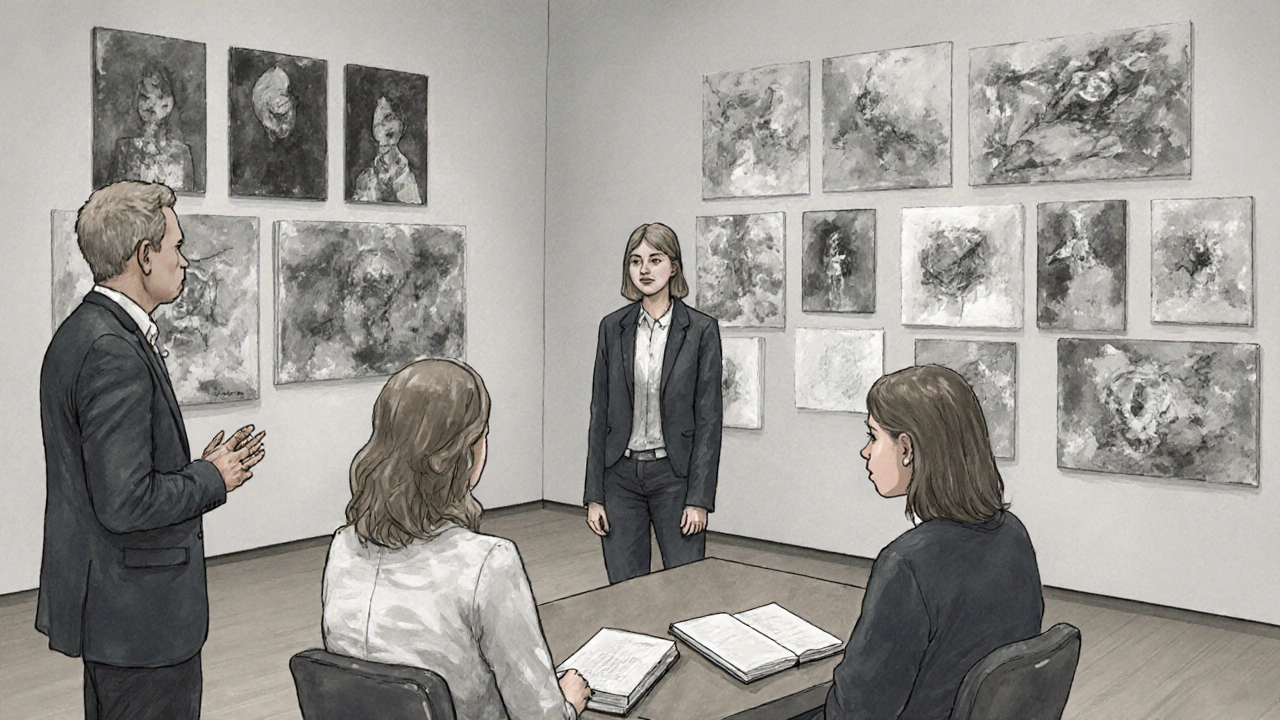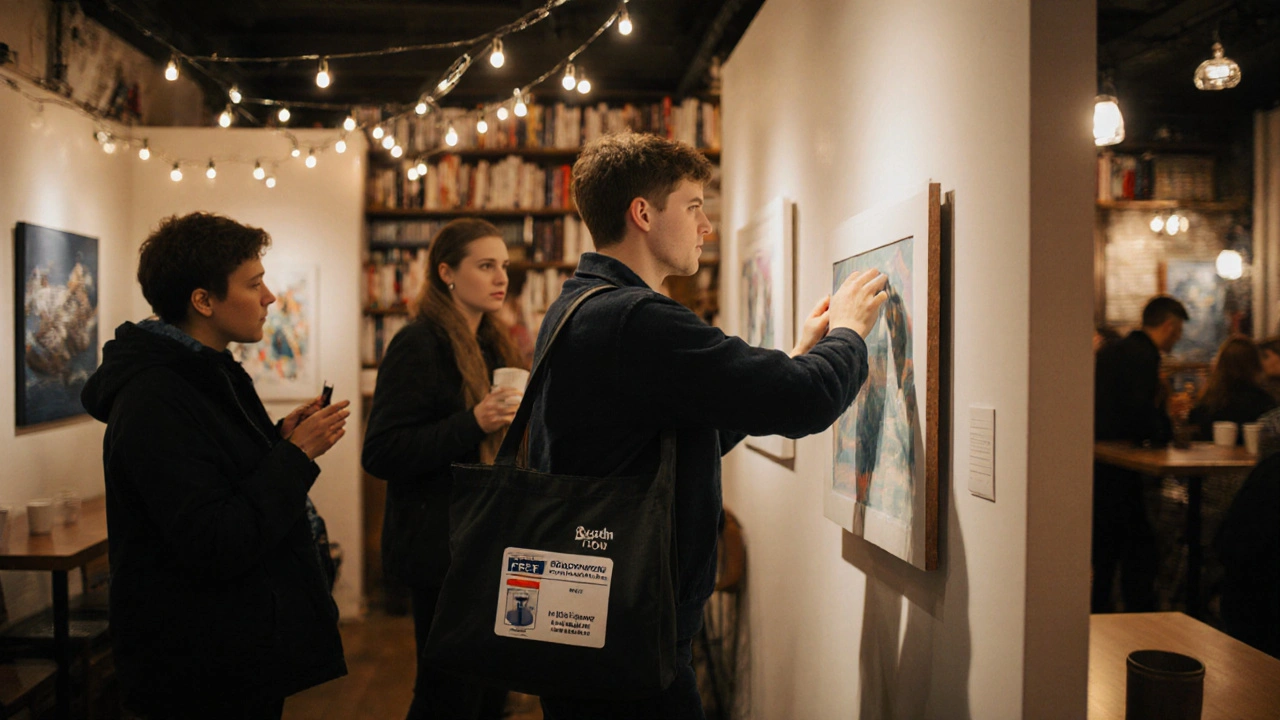
If you're serious about studying creative arts in the UK, the difference between a good university and a great one isn’t just the name on the diploma. It’s whether your studio space lets you spread out, whether your portfolio gets real feedback from working artists, and whether you actually get to show your work to people who matter. Too many students pick a school based on rankings or campus photos-only to end up stuck in a cramped studio with no gallery access and a professor who hasn’t made art in five years.
Studios: Space Is Your First Tool
Don’t assume all art studios are the same. At some universities, you’ll share a 4x4 meter room with three other students. At others, you’ll have a private 12x12 meter studio with floor-to-ceiling windows, natural light, and storage for large canvases or sculptures. That’s not luxury-it’s necessity.
For example, Goldsmiths, University of London, gives every fine arts student a dedicated studio space from day one. You don’t apply for it. You just get it. Meanwhile, some regional universities still assign studio slots by year, meaning first-years might be crammed into converted storage closets. Ask for floor plans. Visit during open days. Measure the space with your phone. If you work with clay, wet media, or metal, check if the studio has proper ventilation, sinks, and waste disposal. Some schools charge extra for access to specialized equipment like kilns or print presses-make sure those costs are built into your budget.
The best studios aren’t just big-they’re alive. Look for schools where students leave work out overnight, where paint splatters are part of the floor, where you can walk in at 2 a.m. and find someone else working. That culture matters more than the square footage.
Portfolio: It’s Not Just for Applications
You’ve heard that your portfolio is your ticket in. But here’s what no one tells you: your portfolio is your learning tool, too. At top UK art schools, portfolio reviews aren’t one-time events. They happen every term. You present your work to a panel of tutors and visiting artists. You get blunt feedback. You’re asked to defend your choices. You’re pushed to go further.
At the Royal College of Art, students go through three major portfolio reviews per year. Each one is recorded, and you’re given a written critique from at least three professionals. That’s not grading-it’s training. You learn how to talk about your work like an artist, not a student.
Compare that to schools where portfolio feedback is just a quick comment on a Moodle page. Or worse-where you’re told your work is "interesting" but never why, or how to improve. If a university doesn’t have a structured, recurring portfolio review process with external critics, you’re missing out on real growth.
Also, check if the program encourages you to build a digital portfolio early. Most galleries, residencies, and grad schools now expect a clean, mobile-friendly online presence. A school that teaches you how to shoot your work, write artist statements, and organize your site from year one gives you a huge edge.
Exhibitions: Where Your Work Becomes Public
It’s easy to think exhibitions are just for final-year shows. But the best creative arts programs treat every show as a learning opportunity. At the Glasgow School of Art, first-year students are invited to exhibit in the student-run gallery. Second-years curate group shows. Third-years apply to show in off-campus spaces like cafes, libraries, or pop-up galleries across the city.
Why does this matter? Because art doesn’t live on a hard drive. It lives in public space. The moment someone stops, looks, and asks you a question about your piece-that’s when you start thinking like a professional.
Ask: How many exhibitions happen each year? Are they open to the public? Do local curators or gallery owners attend? Does the school cover installation costs? Some schools make students pay to hang their work. Others partner with commercial galleries and give students a 70% cut on sales.
At Chelsea College of Arts, students in their final year get a solo show in the college’s main gallery. The opening is promoted in ArtReview and featured on the school’s website. That’s not just a party-it’s a career launchpad. Alumni from that program have gone on to show at Tate Modern, the Venice Biennale, and commercial galleries in London and Berlin.

Faculty: Who’s Teaching You?
Don’t just check the faculty list. Check their recent work. Look up their exhibitions on Artforum or Frieze. See if they’ve published in journals like Studio International or contributed to artist books. If the head of the program hasn’t made new work in the last three years, that’s a red flag.
Some universities hire retired academics who’ve never worked outside the classroom. Others hire active artists who still show in galleries, run residencies, and get grants. The difference is huge. An artist who’s currently exhibiting will know what galleries are looking for. They’ll know which residencies are worth applying for. They’ll tell you which art fairs matter-and which are just expensive networking events.
At the Slade School of Fine Art, nearly all full-time tutors are practicing artists with recent solo shows. One tutor just finished a residency at the British School at Rome. Another had a piece acquired by the V&A Museum last year. That’s not a resume line-it’s a live connection to the art world.
Location: City vs. Campus
London isn’t the only option. But if you want access to galleries, auctions, artist talks, and studio visits, you need to be near the action. Manchester has a thriving indie art scene. Newcastle has strong ties to the Baltic Centre. Birmingham’s Moseley Road studios host monthly open nights.
Some schools are tucked away in quiet towns. That’s great if you want peace. But if you’re hoping to intern at a gallery, attend a Frieze Masters talk, or meet a curator at a vernissage, you’ll be traveling every weekend. Ask about public transport. Ask if the school organizes group trips to London, Edinburgh, or Liverpool.
At the University of the West of England in Bristol, students get free bus passes to Tate Britain and the Arnolfini gallery. That’s not a perk-it’s part of the curriculum.

What to Ask Before You Apply
- Do I get my own studio space, and for how long?
- How often are portfolio reviews held, and who conducts them?
- How many public exhibitions happen each year? Are students included?
- Are there opportunities to show work outside campus?
- Who are the current tutors? Where have they exhibited recently?
- Is there funding for materials, travel, or exhibition costs?
- Do students get help building digital portfolios and artist websites?
Final Thought: Your Art Doesn’t Wait
The UK’s creative arts scene moves fast. Galleries don’t wait for you to graduate. Residencies don’t wait for you to feel ready. If you’re serious about making art, your university should feel like a launchpad-not a waiting room. Choose a school that treats your work like it matters now, not just after you’ve paid your tuition.
Do I need a portfolio to get into a UK creative arts program?
Yes. Most UK creative arts degrees require a portfolio as part of the application. But it’s not just about showing finished pieces. Admissions teams look for process-sketches, experiments, failed attempts, and how you’ve developed your ideas. A portfolio that shows curiosity and growth often beats a polished but empty one.
Are UK art schools expensive for international students?
Yes, they can be. International tuition for creative arts degrees typically ranges from £22,000 to £30,000 per year. But some schools offer scholarships for portfolio-based applicants. The Royal College of Art, for example, gives over £2 million in scholarships annually. Also, check if your home country has a government grant for studying abroad-many do.
Can I switch studios or specializations after starting?
It depends. Some schools, like Goldsmiths and Camberwell, let you switch between fine art, sculpture, or digital media in your first year. Others lock you into a specialization from day one. Ask about flexibility before you enroll. If you’re unsure whether you want to work in painting or installation, choose a school that lets you explore first.
What’s the difference between a BA and BFA in the UK?
In the UK, most creative arts degrees are called BA (Bachelor of Arts), even if they’re studio-based. The BFA (Bachelor of Fine Arts) is an American term and rarely used here. Don’t be fooled by schools that use "BFA"-they’re likely marketing it to appeal to international students. Focus on the curriculum, not the degree title.
Do UK art schools help with finding jobs after graduation?
Some do, some don’t. Top schools like the RCA and Slade have dedicated career services that connect students with galleries, studios, and arts organizations. They host job fairs, offer freelance contracts, and even help with visa applications for non-EU graduates. At smaller schools, you’re often on your own. Ask about alumni outcomes: where did last year’s grads end up? Did they get gallery representation? Residencies? Grants?